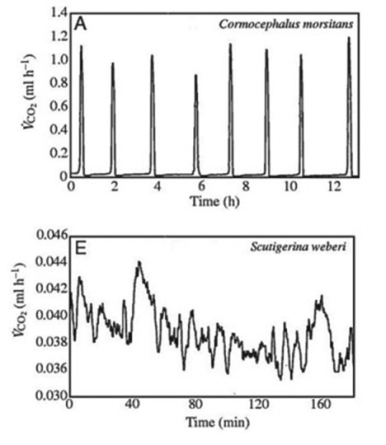Multiple Choice
Use the following information and figures to answer the question.
Many terrestrial arthropods exchange gases with their environments by using tracheae, tubes that lead from openings (called spiracles) in the animal's exoskeleton or cuticle directly to the animal's tissues. Some arthropods can control whether their spiracles are opened or closed; opening the spiracles allows the carbon dioxide produced in the tissues to travel down the tracheae and be released outside the animal. Klok et al. measured the carbon dioxide emitted over time (represented by ⱽCO₂) by several species of centipedes. The figures present graphs of their results for two species, Cormocephalus morsitans and Scutigerina weberi.
How would a terrestrial centipede most likely benefit from the ability to close its spiracles? Closing spiracles would ________.
A) allow the centipede to move more quickly
B) allow the centipede to retain more moisture in its tissues
C) allow the centipede to stay warmer
D) allow more oxygen from the environment to reach the centipede's tissues
Correct Answer:

Verified
Correct Answer:
Verified
Q27: The water vascular system of echinoderms _.<br>A)
Q30: Use the following information to answer the
Q32: Which one of these mollusc groups can
Q33: Which of the following can be found
Q34: Use the following information to answer the
Q36: Against which hard structure do the circular
Q37: In a tide pool, a student encounters
Q38: If a lung were to be found
Q39: The sea slug Elysia chorotica has no
Q40: Whiteflies are common pest insects found on